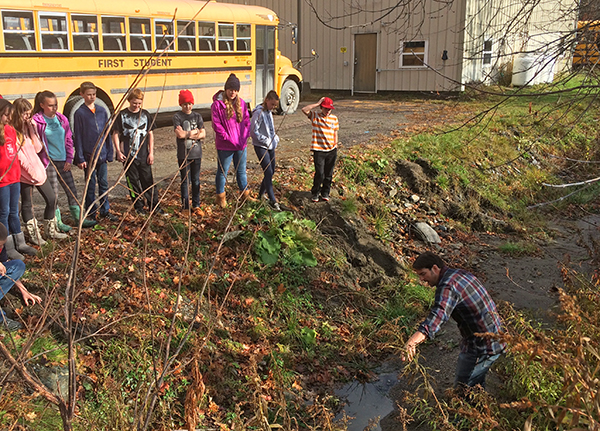Friends of the Mad River (FMR) is back in school just like everyone else and working with local schools to keep water clean and strengthen the community’s resilience to flooding. Harwood Union and Friends of the Mad River have just completed a planning and engineering project that takes the school’s nine-acre campus one big step closer to sustainability.
“We are very happy with the outcomes from this work and hope to secure the funding in the future to implement these designs,” said Ray Daigle, Washington West Supervisory Union director of facilities and operations.
A grant from the Vermont Department of Environmental Conservation’s (DEC) Clean Water Initiative allowed Harwood administrators, facilities managers and teachers to work with FMR, the Duxbury Planning Commission and Watershed Consulting Associates over the last year to study the water runoff from the campus’s impervious roofs and parking lots and to engineer solutions that reduce the negative impact on the adjacent Lozelle Brook and on downstream communities.
“At Harwood Union we have been concerned with the impacts of stormwater runoff on the brook. However, without adequate funding to address the issue it has been on the back burner,” Daigle noted.
Now the school board has shovel-ready plans at its fingertips as it makes facilities improvements over the next several years. When implemented, the projects designed will significantly reduce runoff volume and pollutant-load, improving water quality and reducing downstream flooding in addition to helping Harwood meet impending permit requirements called for by Vermont’s 2015 Water Quality Act.
“We understand that in the next few years the regulations around stormwater runoff will only get more stringent and this opportunity to work with the Friends of the Mad River on this issue is in the best interest of the school and community,” Daigle said. “‘Cooperation’ is the word of the day as our community adapts,” he added.
The designs include a large “rain garden” outside the middle school science classrooms that filters roof runoff before it enters the underground pipes to Lozelle Brook and serves as an outdoor classroom with water quality test holes, native shrubs and grasses and classroom seating.
“Working with Friends of the Mad River and Watershed Consulting Associates on this project has provided students an opportunity to connect classroom learning with real problems that our watershed and community face. We are motivated to see the next steps of this work play out on the Harwood campus and look forward to managing a rain garden right out our door,” reported Angela Selvaggio, a seventh-grade science teacher.
Furthermore, Watershed Consulting Associates engineered two large arrays of under-parking-lot water storage chambers to filter and hold the water after a storm event and release it slowly into the brook, reducing flash flooding downstream and serving as an irrigation tank for the high school’s sports fields.
Brian Fitzgerald, chair of the Duxbury Planning Commission, said, “This project advances Duxbury’s planning goal of reducing the impacts of the built environment on the town’s water resources. The town commends the Friends and Harwood for taking these steps.”
“As part of our Ridge to River initiative, FMR is working with people across the watershed to minimize the harm stormwater runoff can cause to our community. We’re pleased to have worked so closely with Harwood in designing projects that do this while also enhancing the way the campus works for staff and students,” said Corrie Miller, Friends of the Mad River executive director.
“FMR is also thrilled to announce a new grant award from DEC’s Ecosystem Restoration Program for similar work with Fayston and Warren elementary schools,” Miller added.
“Hurricane Irene’s destruction in the Mad River Valley has provided students, families, and our school with a lot to think about in terms of our relationship with waterways,” Jean Berthiaume, Fayston Elementary School’s principal, pointed out. “We believe that this new project will provide us with an incredibly rich and authentic learning experience on our school grounds.”
Katie Sullivan, a teacher at Warren Elementary, sees value in “students having an opportunity to see a stormwater retrofit transform their school's infrastructure, while also seeing school administrators modeling environmentally responsible behavior.”
Both campuses contribute runoff to adjacent streams and downstream communities. As the school year gets underway, FMR will work with school administrators, facilities operators, teachers and parents to analyze the campus and develop engineering designs for priority projects that enhance the school’s educational opportunities and environmental sustainability.
“Because the Mad River Valley is mostly a rural landscape, the schools are some of our biggest paved areas with aging infrastructure where we can really have a big positive impact on clean water and resilience,” Miller said. “I’m excited that Warren and Fayston schools see so many potential benefits in this work together.”
Friends of the Mad River is a community-supported organization committed to active and thoughtful stewardship of the Mad River and its 144-square-mile watershed. For more information about Friends of the Mad River, visit www.FriendsoftheMadRiver.org.







